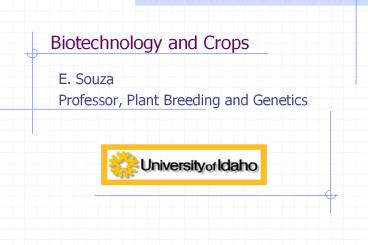Biotechnology and Crops - PowerPoint PPT Presentation
1 / 25
Title:
Biotechnology and Crops
Description:
Biotechnology and Crops E. Souza Professor, Plant Breeding and Genetics Basic Areas of Biotechnology Research Sequence and Function Sequencing all the DNA of corn ... – PowerPoint PPT presentation
Number of Views:128
Avg rating:3.0/5.0
Title: Biotechnology and Crops
1
Biotechnology and Crops
- E. Souza
- Professor, Plant Breeding and Genetics
2
Basic Areas of Biotechnology Research
- Sequence and Function
- Sequencing all the DNA of corn, rice, and
Arabidopsis (a small mustard). - Comparable Human research The Human Genome
Project
3
Sequence and function
TATAGTCCAUG Gene sequence
TATAGTCCAUG Gene sequence
Design DNA probes
Arabidopsis
Potato
Model proteins
New understanding of plant function and faster
approaches to crop improvement
Protein structure and function
4
Basic Areas of Biotechnology Research
- Structure and Function
- Diagnostics
- Identifying genes that cause disease resistance
or quality enhancement. - Human research Identifying cancer genes
5
Consensus map Triticeae Group 1
Chromosome. Wheat Rye Barley Rice Maize Source
Graingenes
6
Autoradiogram of DNA marker from oat CDO64 One
of many gene markers used to construct maps of
cereals. Source Graingenes
7
Difficult traits such as head scab resistance
are easier to select by selecting directly for
DNArather than the disease
Marker Assisted Selection
Smaller DNA
Large DNA
8
Basic Areas of Biotechnology Research
- Structure and Function
- Diagnostics
- Genetic Engineering of Crops
- Defined by transfer of genetic material from one
organism to another through non-sexual means - Comparable human research Gene therapy
treatments
9
Genetic Engineering of Crops
- Isolation of gene
- Development of new construct or vector
- A carrier often small circular or linear DNA
- Other genes for efficient transfer
- Regulatory genes to activate the target gene
- Insertion into plant
- Selection and recovery of plants with activated
gene
10
Regulation of Genetically Engineered Plants
- GE plants for lab use
- Regulated by internal biological safety
committees - Vast majority of engineering events
- Field testing and transport APHIS
- Safety and use EPA, FDA, or both
- Marketing All of the above plus other nations
regulatory agencies
11
Frequency of Journal Publications Listed in
AGRICOLA Database
12
Traits Used for Enhancing Crops
- Herbicide resistance
- Roundup ready
- Bialophos resistant
- Bromoxinyl resistant
- Bt organic insecticide
- Different forms of Cry proteins from a pathogen
of insects - Virus resistance
- coat protein genes
13
Potatoes in foreground are normal, background
protected from Round-up Herbicide by a modified
enzyme from bacteria.
14
Potatoes with Cry proteins from B. thuringensis
protected fromColorado potato beetles
15
Genetically Enhanced Daws Wheat Resistant to
Wheat Streak Mosaic Virus from 96-97 Field Test
16
Types of traits incorporated into genetically
enhanced crops, 2002
Source C. James, 2002, ISAAA
17
Percent of land area planted to transgenic crops
by country 2003 total global land area
planted 167 million acreshttp//www.colostate.ed
u/programs/lifesciences/TransgenicCrops/current.ht
mlcrops
18
Relative percent of transgenic cultivars by crop,
2002 http//www.isaaa.org/kc/Publications/pdfs/isa
aabriefs/Briefs2027.pdf
19
Traits Used for GE Crops Crop Quality
- Ripening gene modifications
- Pharmaceuticals and Vaccines
20
Traits Used for GE Crops Crop Quality
- Ripening gene modifications
- Pharmaceuticals and Vaccines
- Vitamin A enhancement of rice
- Additional gluten genes
- Oil composition
- Essential oils/flavors
21
GE Crops Risks and Problems
- Consumer acceptance
- Safety/allergenicity (Perceived and actual)
- Naturalness
22
GE Crops Risks and Problems
- Consumer acceptance
- Poor Utilization
- Traits are expensive the cost of technology as
described in essay - Tendency to overuse
23
GE Crops Risks and Problems
- Consumer acceptance
- Naturalness
- Poor Utilization
- Weediness
- Weediness of crop
- Escape of genes
24
GE Crops Risks and Problems
- Consumer acceptance
- Naturalness
- Poor Utilization
- Weediness
- Safety/Labeling
- Segregation of products expensive
- Labeling is cheap the process to match the food
to the label is very expensive
25
So Why Do Genetic Engineering?
- In some cases we will not
- Roundup Ready Wheat Terminated in 2004
- Reduce costs and lower agricultures
environmental impact - less pesticides
- lower rate and toxicity
- Traits available throughout third world
- Competitive edge?































